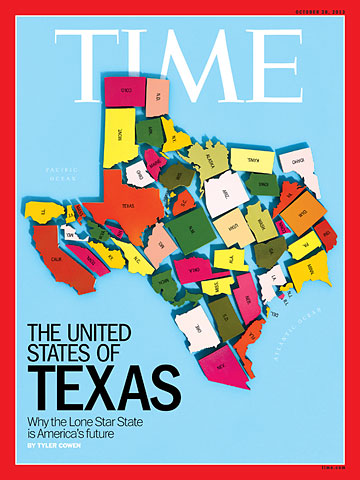
(2 of 9)
To a lot of Americans, Texas feels like the future. And I would argue that more than any other state, Texas looks like the future as well--offering us a glimpse of what's to come for the country at large in the decades ahead. The U.S. is experiencing ever greater economic inequality and the thinning of its middle class; Texas is already one of our most unequal states. America's safety net is fraying under the weight of ballooning Social Security and Medicare costs; Texas' safety net was built frayed. Americans are seeking a cheaper cost of living and a less regulated climate in which to do business; Texas has those in spades. And did we mention there's no state income tax? (Texas is one of only seven states in the union that lack the levy.)
There's a bumper sticker sometimes seen around the state that proclaims, i wasn't born in Texas, but i got here as fast as i could. As the U.S. heads toward Texas, literally and metaphorically, it's worth understanding why we're headed there--both to see the pitfalls ahead and to catch a glimpse of the opportunities that await us if we make the journey in an intelligent fashion.
AVERAGE IS OVER
The first thing to understand about our more Texan future is what's happening to the American workforce on the whole: average is over.
More and more workers are leaving the middle class--headed both up and down--and fewer workers are moving into it. Median household income has fallen about 5% since the Great Recession ended in 2009; in that same period, 58% of job growth was in lower-wage occupations, defined as those paying $13.83 an hour or less.
However, it's not that incomes are stagnant generally. Earners at the top have done very well--but the gains have been distributed quite unevenly. Last year the top 1% of earners took home 19.3% of household income, their largest share since 1928. The top 10% of earners didn't do so badly either, taking home a record 48.2% of household income.
We know the forces driving this: globalization, advances in computing, and automation mean that Americans are facing tougher competition than ever before from workers overseas, machines and smart software. The individuals moving up the economic ladder are the ones who've responded to this competition by upgrading their skills and efforts. The ones moving down are largely those who have failed or been unable to respond at all.
The group struggling the most is the young. People with four-year college degrees earn less today than graduates did in 2000, and over time this will translate into persistently lower earnings. And too many young people today, even if they have jobs, have failed to establish themselves on career ladders. If we look at Americans ages 16 to 24 who are not enrolled in school, only 36% are working full time, 10% less than in 2007. A 24-year-old who is working part time for a website, as a Pilates instructor or in retail may be having fun, but he or she probably won't be receiving strong promotions a couple of decades down the line.
